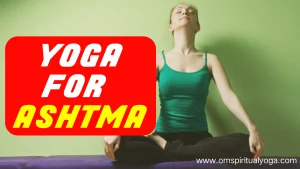Today, you will learn a selected process for respiratory problems, with a primary focus on yoga for asthma. The risk factors for respiratory issues include aridity, constant tension, an improper diet, and excessive intake of liquids, including water. When you consume excessive water, it can lead to water retention in the body, causing a drop in body temperature and potentially leading to colds, sinus issues, and asthma. To avoid this, limit your daily water intake to around 2 to 2.2 liters.
Living in a polluted area can also contribute to respiratory problems, including asthma.

ASANA-1
Mr. Sak Kumaran, who has been attending our classes for ten years, has achieved remarkable balance in his practice. Let’s begin with the ASANA. Stand with your feet one foot apart, arms at your sides. Join your palms and interlock your fingers. Exhale and bend your trunk forward. Exhale again as you raise your arms. Hold your breath briefly, then lower your arms as you inhale and return to an upright position. Repeat this practice ten times.
Also Read – 4 Simple Ways to be Mindfulness For Everyday Life
ASANA-2
Now, step your legs apart, keeping them one foot apart. Extend your arms out in a horizontal position. Place your palms on your waist, exhale, and bend your trunk backward. Hold this pose for about 60 seconds, taking deep breaths. You should apply pressure to the lungs and keep your legs apart. Rest your palms on your waist with your fingers pointing sideways. Inhale and return to a standing position to complete the practice.
ASANA-3
Rise up onto your knees with your feet one foot apart. Toes should point outward. Extend your arms horizontally and gently move them back. Rest your palms on your waist, exhale, and bend your trunk backward. Hold this pose for about 60 seconds, taking deep breaths and expanding your chest. Inhale and return to the Vajrasana pose.
Tiger Breathing: Now, let’s practice Tiger Breathing. Keep your legs apart, with one-arm distance between your knees and arms. Raise your head and create a concave shape in your back as you inhale. Exhale, lowering your head and resting your chin on your collarbone, arching your back like an archer’s bow. Practice this breathing exercise ten times. Inhale as you raise your chest and head, creating the concave shape. Exhale as you lower your head and rest your chin on your collarbone, arching your back. Inhale, and exhale. Practice this sequence ten times.
ASANA-4
Now, come to the Vasana pose and relax. Bend your legs at the knees, sit on your feet, and rest your left arm on your right leg. Place your right palm on the ground on the back side of your body. Exhale as you turn your spine to the left, turning your head to look behind you. Hold this pose for about 60 seconds while taking deep breaths. Inhale and return to the resting pose.
Alternate Practice with Wall: You can practice these asanas using the support of a wall. Place your legs together, exhale, and fold your legs at the knees, keeping your heels close to your hips. Hold your legs with your hands and apply pressure to your stomach. Keep your head straight and hold this pose for about 60 seconds while taking deep breaths.
Pana Mritasana: This asana is called Pana Mritasana. It’s better to practice it every day before Shavasana. Pana means gas, and Mritasana means release. This asana helps in removing gas accumulated in the digestive tract.
Inhale, come to the Shavasana pose, and relax. We inhale more than 50 billion dirt particles every hour. It’s essential to clean the windpipe regularly. This can be achieved through pranayama.
Kapalbhati: First, practice Kapalbhati pranayama. Sit with your palms resting on your stomach and exhale through the nose with force. Inhale through the nose, and exhale with force. Repeat this process to clear the windpipe.
Maha Pranayama: Next, practice Maha pranayama. Adopt chin mudra in your left hand and nasika mudra in your right hand. Inhale through the left nostril, then exhale through the right nostril. Inhale through the right nostril and exhale through the left nostril. Repeat this sequence nine times.
Gently take your arms down, come to the resting pose, and relax.
Practice all these asanas in sequence and follow the tips to benefit your respiratory health.

